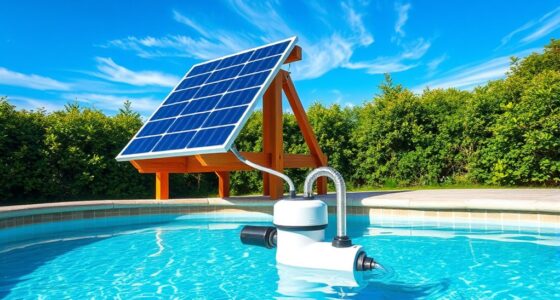Natural swimming pools offer a chemical-free, eco-friendly way to enjoy a back-to-nature experience. By using biological filters, native plants, and natural ecosystems, these pools keep water clear and clean without chlorine or chemicals. You’ll benefit from a healthier, tranquil environment that blends seamlessly with your surroundings. With proper design and maintenance, you can create a sustainable, beautiful space that supports local wildlife. Continue exploring to discover how to make your own natural haven.
Key Takeaways
- Natural swimming pools use biological and physical filtration systems to keep water clean without chemicals.
- Native plants like reeds and sedges support water purification and enhance ecological balance.
- These pools mimic natural ecosystems, offering a chemical-free, healthier swimming environment.
- Proper design and native vegetation reduce maintenance and promote a self-sustaining, eco-friendly pool.
- They provide a tranquil, back-to-nature experience that benefits health, environment, and water quality.

Have you ever wondered if you can enjoy swimming in a pool that’s eco-friendly and chemical-free? Natural swimming pools make that possible. Unlike traditional pools that rely on chlorine and other chemicals, these pools use eco friendly filtration systems to keep the water clean and clear. You won’t have to worry about harsh chemicals irritating your skin or harming the environment. Instead, they depend on biological processes and natural elements to maintain water quality. This approach creates a healthier, more sustainable swimming experience that aligns with a back-to-nature lifestyle.
One of the key features of natural pools is their use of eco friendly filtration. These systems typically combine biological filters with physical filtration methods, such as gravel and sand beds. As water circulates through these layers, beneficial bacteria break down organic matter, algae, and pollutants naturally. This biological filtration is efficient and reduces or eliminates the need for chemical treatments. The process mimics natural ecosystems, where plants and microorganisms work together to purify water. When designing your natural pool, selecting the right native plants is essential. Native plant selection not only enhances the aesthetic appeal but also supports local biodiversity. These plants are well-adapted to your climate and soil, so they thrive with minimal maintenance. They also help stabilize the ecosystem by providing habitat for beneficial insects and wildlife, which further contributes to water quality. When choosing native plants for your natural pool, consider species known for their water-filtering abilities, such as reeds, sedges, and bulrushes. These plants grow naturally along riverbanks and wetlands and are excellent at absorbing nutrients that could otherwise promote algae growth.
Additionally, maintaining proper location and installation considerations is vital to ensure your eco-friendly pool functions effectively and safely. The arrangement of native plants around your pool’s margins can also create a natural barrier, preventing debris from entering the water and reducing maintenance needs. By integrating native plant selection into your design, you create a self-sustaining system that requires less intervention over time. This approach not only keeps your pool clean but also fosters a balanced ecosystem that supports local flora and fauna. The overall experience is more harmonious with nature, offering you a tranquil swimming environment that’s free from chemical smells and residues. Plus, the visual appeal of lush, native plants adds a natural, serene atmosphere to your backyard oasis. With eco friendly filtration methods and thoughtful native plant selection, you can enjoy a revitalizing swim while respecting and preserving the environment. It’s an investment in your health and the planet, providing a sustainable alternative that truly reconnects you with nature.
Frequently Asked Questions
How Much Do Natural Swimming Pools Typically Cost to Build?
Building a natural swimming pool typically costs between $20,000 and $50,000, depending on size, design, and site conditions. You should start with a detailed cost estimation to stay within your budget, considering excavation, filtration systems, plants, and materials. Proper budget planning guarantees you cover all aspects of construction and maintenance, making your back-to-nature experience enjoyable without unexpected expenses. Keep in mind that costs can vary based on your specific preferences and location.
What Maintenance Is Required for Natural Swimming Pools?
You’ll love the minimal fuss of maintaining your natural pool, right? Just biological filtration and algae control are your main tasks. You’ll need to monitor water quality, clean out debris, and occasionally manage plant growth. It’s almost like a pet—you care for it daily, but instead of feeding, you’re balancing ecosystems. Ironically, keeping it pristine is simpler than chemical pools, making your backyard a true nature sanctuary.
Are Natural Pools Suitable for All Climates?
Natural pools can be suitable for many climates, but you need to consider climate adaptability and regional construction considerations. In colder regions, you might need to winterize or insulate your pool to prevent damage. In hot climates, maintaining the balance of biological filters is vital. You should research local conditions and adapt your natural pool design accordingly, ensuring it functions well year-round and fits your area’s specific climate challenges.
How Long Does It Take to Establish a Natural Swimming Pool?
Establishing a natural swimming pool typically takes about three to six months, depending on your water plant selection and pool design considerations. Patience is key as beneficial bacteria and plants work harmoniously to create a balanced ecosystem. You’ll see quick progress with proper planning, but full clarity and biological balance develop gradually. Stay attentive to your pool’s needs, and you’ll enjoy a thriving, chemical-free oasis sooner than you might expect.
Can Natural Pools Be Integrated Into Existing Landscapes?
Yes, you can integrate natural pools into your existing landscape. You’ll need to take into account design aspects like placement, surrounding vegetation, and terrain to ensure seamless landscape integration. Think about how the pool complements your yard’s aesthetics and functionality. Incorporate native plants and natural materials to enhance the back-to-nature feel. Proper planning ensures your natural pool blends beautifully with your landscape while maintaining ecological balance.
Conclusion
Imagine diving into a crystal-clear pool surrounded by lush greenery, where the water feels pure and inviting without any chemicals. With a natural swimming pool, you get to embrace a back-to-nature experience that’s both invigorating and eco-friendly. Picture yourself swimming peacefully, the gentle rustling of leaves above, and the warm sun on your skin. It’s more than just a swim — it’s a tranquil escape into a vibrant, chemical-free oasis that reconnects you with nature.









